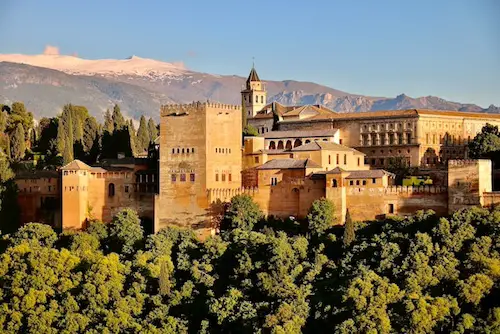As an Amazon Influencer, we earn from qualifying purchases you might make if you click any of the links on this page.
Europe is a cultural treasure trove, offering a rich tapestry of history, art, and architecture. The Doge’s Palace in Venice and the Acropolis in Athens showcase ancient grandeur and artistic achievements. The Louvre in Paris and the Vatican Museums in Vatican City house masterpieces spanning millennia.
Check These for More European Vacation Tips:
Finding the Right Cultural Places in Europe for You!
The Alhambra in Granada and the Sagrada Familia in Barcelona highlight exquisite architectural styles. London’s British Museum and St. Petersburg’s Hermitage Museum offer vast collections of global artifacts. The Colosseum in Rome stands as a testament to Roman engineering and public spectacles, while the Anne Frank House in Amsterdam provides a poignant reminder of World War II.
Each destination offers a unique glimpse into Europe’s diverse cultural heritage, making them must-visit sites for any traveler seeking to explore the continent’s rich history and artistic legacy. Let’s break down all the best places in Europe for you to visit for a unique cultural experience!
The Doge’s Palace, Venice, Italy
The Doge’s Palace in Venice is a stunning example of Gothic architecture and a symbol of Venetian power and opulence. Built in the 14th century, this palace served as the residence of the Doge, the supreme authority of the former Republic of Venice. Visitors can explore the grand chambers, admire the intricate artworks by masters like Tintoretto and Veronese, and walk across the iconic Bridge of Sighs.
Purchasing Doge’s Palace tickets allows you to experience the palace’s blend of political history and artistic grandeur, making it a captivating cultural landmark. As you step into the palace, you are greeted by the grand Scala dei Giganti, a magnificent staircase leading to the Doge’s apartments.
The lavishly decorated rooms, such as the Sala del Maggior Consiglio, reflect the wealth and power of the Venetian Republic. The palace also houses the prison cells where infamous prisoners like Casanova were held, providing a glimpse into the darker side of Venetian history.
The Acropolis, Athens, Greece
Standing proudly above Athens, the Acropolis is the epitome of ancient Greek civilization. This ancient citadel, dating back to the 5th century BC, is home to several iconic structures, including the Parthenon, the Temple of Athena Nike, and the Erechtheion.
The Parthenon, with its Doric columns and timeless design, symbolizes the glory of ancient Greece. A visit to the Acropolis offers a profound insight into Greek mythology, art, and philosophy. For Acropolis Athens tickets, visitors can easily obtain them either online or at the entrance.
The Acropolis Museum, located nearby, houses a vast collection of artifacts from the site, providing context and depth to the ruins. Walking up the rocky hill to the Acropolis, you can almost feel the presence of the ancient Athenians who once gathered here. The panoramic views of Athens from the top are breathtaking, offering a perfect blend of historical and natural beauty.
Check These for More on Greece:
The Louvre Museum, Paris, France
The Louvre Museum in Paris is the world’s largest art museum and a historic monument in its own right. Originally a royal palace, the Louvre became a public museum during the French Revolution. It houses an unparalleled collection of art, including the Mona Lisa, the Venus de Milo, and countless other masterpieces spanning millennia.
Walking through its vast galleries, visitors can trace the evolution of art and culture from ancient civilizations to the modern era. The Louvre’s iconic glass pyramid entrance, designed by I.M. Pei, is a modern architectural masterpiece that contrasts beautifully with the historic palace.
Inside, the museum’s extensive collections are organized into eight departments, ranging from Near Eastern antiquities to Islamic art. Highlights include the Egyptian mummies, the Winged Victory of Samothrace, and the sumptuous Napoleon III Apartments.
The Alhambra, Granada, Spain
The Alhambra is a breathtaking palace and fortress complex in Granada, Spain. Built during the mid-14th century by the Nasrid sultans, the Alhambra showcases the pinnacle of Moorish architecture and design. Its intricate stucco work, serene courtyards, and stunning views of the Sierra Nevada mountains create an atmosphere of timeless beauty and tranquillity.

The Alhambra’s rich history and exquisite craftsmanship make it a must-visit cultural destination. Visitors can wander through the lush Generalife gardens, explore the ornate halls of the Nasrid Palaces, and marvel at the Alcazaba fortress.
The Hall of the Ambassadors, with its intricately carved wooden ceiling, and the Court of the Lions, with its iconic fountain, are particularly noteworthy. Each corner of the Alhambra tells a story of the Islamic Golden Age and the blend of cultures that shaped Spain’s history.
The Vatican Museums, Vatican City
The Vatican Museums in Vatican City are a treasure trove of art and history, offering a glimpse into the vast cultural heritage of the Catholic Church. Visitors can explore a series of galleries, chapels, and apartments filled with masterpieces by artists such as Michelangelo, Raphael, and Caravaggio.
The Sistine Chapel, with Michelangelo’s iconic ceiling frescoes, is a highlight of any visit. The Vatican Museums’ collection reflects the church’s influence on art and culture throughout history. The Raphael Rooms, adorned with frescoes depicting significant moments in history and theology, are a testament to the Renaissance master’s genius.
The Gallery of Maps offers a fascinating look at 16th-century cartography. The Vatican Museums also house an impressive collection of classical sculptures, including the Laocoön Group and the Apollo Belvedere, which have inspired artists for centuries.
More on Italy Here:
The Sagrada Familia, Barcelona, Spain
The Sagrada Familia in Barcelona is an architectural marvel designed by Antoni Gaudí. Although construction began in 1882 and continues to this day, the basilica’s unique design and towering spires already make it one of Europe’s most iconic cultural landmarks. Gaudí’s vision blends Gothic and Art Nouveau styles, creating a structure that is both fantastical and deeply spiritual.
The Sagrada Familia’s intricate facades and stunning interior reflect Gaudí’s innovative spirit and deep faith. The Nativity Facade, with its detailed sculptures depicting scenes from Christ’s birth, contrasts with the more austere Passion Facade, illustrating the crucifixion.
Inside, the basilica’s forest-like columns and vibrant stained glass windows create a mesmerizing play of light and colour. Gaudí’s integration of nature and architecture is evident throughout, visiting the Sagrada Familia a truly immersive experience.
The British Museum, London, England
The British Museum in London is one of the world’s greatest repositories of human history and culture. Established in 1753, it houses a vast collection of artifacts from around the globe, including the Rosetta Stone, the Elgin Marbles, and the Egyptian mummies.
The museum offers a comprehensive journey through human civilization, showcasing the interconnectedness of cultures across time and space. The museum’s Great Court, with its stunning glass roof designed by Norman Foster, is an architectural masterpiece in itself.
Visitors can explore the Egyptian galleries, with their impressive collection of pharaonic artifacts, or delve into the rich history of ancient Greece and Rome. The British Museum’s diverse collections also include treasures from Africa, Asia, the Americas, and Oceania, providing a truly global perspective on human history.
The Hermitage Museum, St. Petersburg, Russia
The Hermitage Museum in St. Petersburg is one of the largest and oldest museums in the world. Founded by Catherine the Great in 1764, it occupies the stunning Winter Palace and several other historic buildings.
The Hermitage’s collection includes over three million items, from prehistoric artifacts to modern art. Its opulent interiors and vast galleries offer a glimpse into Russia’s imperial past and the rich tapestry of world art. The museum’s highlights include the Peacock Clock, an elaborate 18th-century automaton, and the stunning Jordan Staircase.
The Hermitage’s collection of Western European art is particularly renowned, featuring works by Rembrandt, Rubens, and Leonardo da Vinci. The museum also boasts an extensive collection of Russian art, showcasing the country’s rich cultural heritage.
The Colosseum, Rome, Italy
The Colosseum in Rome is an enduring symbol of the grandeur of the Roman Empire. This ancient amphitheater, built in the 1st century AD, could hold up to 80,000 spectators and hosted gladiatorial contests, public spectacles, and dramas. Walking through its ancient corridors, visitors can imagine the roar of the crowds and the dramatic events that once took place here.
The Colosseum’s iconic silhouette against the Roman skyline is a testament to the engineering prowess of ancient Rome. Exploring the Colosseum, you can visit the underground chambers where gladiators and wild animals were kept before contests.
The arena floor, now partially reconstructed, provides a sense of the scale and atmosphere of the ancient spectacles. Nearby, the Roman Forum and Palatine Hill offer further insights into the political and social heart of ancient Rome.
Check These:
- How to Choose the Best Destinations for Your Superyacht Sailing Adventure
- The Most Romantic Places in the World to Propose
The Anne Frank House, Amsterdam, Netherlands
The Anne Frank House in Amsterdam is a poignant reminder of the horrors of World War II and the enduring human spirit. This museum, located in the building where Anne Frank and her family hid from the Nazis, preserves the secret annexe and provides a moving account of Anne’s life through her famous diary.
The Anne Frank House is not just a historical site but a powerful symbol of resilience and hope. Visitors can walk through the narrow corridors and hidden rooms where the Frank family lived in constant fear of discovery.
The original diary, displayed in the museum, brings Anne’s story to life with poignant immediacy. The museum also offers exhibits on the broader context of the Holocaust and the ongoing fight against intolerance and discrimination.
Visiting the Best Cultural Places in Europe!
Exploring these cultural places offers a deep and enriching experience, providing insights into the diverse and interconnected heritage of Europe. Each site tells its own story, inviting visitors to step back in time and witness the extraordinary achievements of past civilizations. Whether you’re an art lover, a history enthusiast, or simply a curious traveler, Europe’s cultural landmarks promise a journey of discovery and inspiration.
















